Improve Narrow-Bore GC Column Performance with Intermediate-Volume (IV) Inlet Liners
- Maximize the high efficiency of narrow-bore columns for fast, sensitive, and highly reproducible results.
- Higher sample capacity than smaller volume liners; faster sample transfer than larger volume liners.
- Reduce the potential for band broadening and analyte breakdown during splitless injection.
|
The benefits of high-efficiency, narrow-bore columns can only be fully realized when sample introduction is also optimized. In this article, we explore the improvements in chromatography and reproducibility generated by using intermediate-volume liners for the following applications:
|
Introduction
Faster analysis times can improve lab productivity, but only if chromatographic performance still allows accurate peak identification and quantification. Narrow-bore GC columns (<0.25 mm ID) speed up analysis because they have greater chromatographic efficiency, producing tall narrow peaks that are easy to identify and keep separated run after run. The efficiency of narrow bore columns is achieved by decreasing the flow rate through the column, which gives analytes more time to interact with the stationary phase. Since these interactions occur over a thinner film and shorter length column, analytes elute quickly as narrow, symmetrical peaks. While using narrow-bore columns can be a good approach to creating fast, highly efficient chromatography with a typical GC-MS setup, their effectiveness is limited by sample introduction.
A variety of inlet options are available to control sample introduction, but the most common tool is a split/splitless inlet. Similarly, many inlet liner styles are available, but for most split/splitless inlets, liners of around 2 mm (“smaller volume”) or 4 mm (“larger volume”) inner diameter (ID) are used. With narrow-bore columns, the smaller liner provides faster sample transfer that better compliments the column’s high efficiency, though there are benefits and drawbacks to both sizes that should be considered (Table I). The choice between larger and smaller volume liners ultimately can require tradeoffs to be made in terms of capacity and chromatographic performance.
Table I: Benefits and Limitations of Different Size Inlet Liners
| Advantages | Disadvantages | |
| Smaller volume |
|
|
| Larger volume |
|
|
Capacity is critical when you need to decrease method detection limits and gain sensitivity. By increasing the injection volume, you can increase the amount of sample on column without having to modify sample preparation procedures. This can be achieved with splitless injection, which transfers the entire sample vapor cloud onto column. However, when splitless injection volume is maximized, the analysis can be greatly affected by inlet temperatures, pressures, and analyte solubility, which can lead to poor chromatography. Balancing these parameters is not a simple task, which is where Restek’s solvent expansion calculator can help. Figure 1 shows the calculated maximum injection volume for different liner sizes under inlet conditions that could reasonably be paired with a narrow-bore column. Depending on the solvent, smaller liners can generally hold 0.5–1 µL, so to really impact limits of detection, larger liners would be used. However, the capacity gain of a larger liner comes at the cost of efficiency. The vapor cloud in a larger liner moves very slowly onto the much narrower head of a narrow-bore column, widening peaks and giving compounds more time to interact with active sites. This can be especially detrimental for compounds that often breakdown in the inlet, such as endrin and DDT.
Figure 1: Maximum injection volume varies by solvent, liner size, and conditions. (Data collected at 250 °C and 40 psi.)
IV Liners Provide a More Balanced Solution
To give narrow-bore column users more flexibility and allow additional sample to be injected, without risking backflash or compromising on peak characteristics, Restek has developed an intermediate-volume option: the IV liner (3 mm ID). Compared to smaller volume (2 mm) liners, IV liners allow injection volumes to be doubled because they have significantly more room to contain solvent vapor clouds. And, since they have faster sample loading capabilities than larger volume (4 mm) liners, good chromatographic performance is maintained because the analytes spend less time in the inlet.
To demonstrate these advantages, we compared the performance of IV liners with smaller and larger liners when paired with narrow-bore columns for the analysis of semivolatiles; polycyclic aromatic hydrocarbons (PAH); and pesticides. Overall, results showed how the IV liner’s intermediate capacity conferred significant improvements in chromatography and reproducibility for splitless injections on narrow-bore columns. Note that the follow experiments compared 2, 3, and 4 mm ID liners in a geometry suitable for Agilent; Thermo TRACE 1300 and 1600 series; PerkinElmer Clarus 590/690 and GC2400; Scion 8300 and 8500; Scion/Bruker/Varian 1177; and Lucidity GCs. An IV liner that is compatible with Shimadzu 17A, 2010, 2014, and 2030 GCs is also available and will achieve similar results.
Analysis of Semivolatiles
To assess the impact of the intermediate-volume IV liner on chromatographic performance for semivolatiles, we paired it with a narrow-bore Rxi-SVOCms column (20 m x 0.15 mm ID x 0.15 µm; cat.# 46616). This column was selected because it is specifically designed for longevity, inertness, consistency, and improved resolution of semivolatile compounds. When used in a narrow-bore format, the column offers the same benefits with shorter run times, but sample introduction becomes essential for maintaining critical separations that may be lost due to solvent effects or peak-widening caused by using the wrong liner.
For this evaluation, we looked at peak characteristics and resolution of 51 semivolatile compounds (cat.#s 31899, 31825, 31826, and 32418) diluted to 1-10 µg/mL. To compare performance to the other liner dimensions without exceeding maximum liner capacities, six 0.5 µL injections were made on the smaller (cat.# 23316) and intermediate (cat.# 27231) volume liners, and six 1 µL injections were made on the larger (cat.# 23303) and intermediate (cat.# 27231) volume liners. By comparing peak area, height, width, resolution, and tailing across compounds and injection parameters, we were able to identify some key benefits to using a IV liner for semivolatiles analysis.
When comparing the 1 µL injections on the intermediate and larger volume liners, peak area and height were significantly improved (Student’s t-test, p < 0.05) for most compounds when using the intermediate-volume IV liner, making peak identification and quantitation easier and more accurate. As shown in Figure 2, 92% of compounds showed greater average peak areas, and 80% showed a greater average peak height when using the IV liner. Peak width, resolution, and symmetry were not statistically different from results for the larger volume liner for most compounds, which was attributed to solvent effects causing poor peak shape for some early eluting compounds using both liners (Figure 3). Performance did improve for early eluting compounds when less sample was injected as well as overall for later eluting compounds (Figures 4–5), which is likely the result of the IV liner’s faster sample transfer onto the column.
For the 0.5 µL injections, which compared the smaller and intermediate-volume liners, the difference was more dramatic: every peak parameter that was investigated showed statistically significant improvements when using the IV liner (Figure 2). These benefits can be attributed to the IV liner providing a narrow sample transfer band and maintaining resolution from the solvent peak. Improved performance was particularly beneficial for better separation of closely eluting isobaric semivolatiles, such as benzo[b]fluoranthene and benzo[k]fluoranthene (resolution of 1.83 vs. 1.93 on the 2 mm and 3 mm liner, respectively, p < 0.05). Overall, for semivolatiles analysis, the IV inlet liner helped translate peak shape and resolution to a narrow-column format, allowing labs to take full advantage of a highly inert, high-efficiency Rxi-SVOCms column.
Figure 2: Effect of Liner on Chromatographic Performance for Semivolatiles on a Narrow-Bore Rxi-SVOCms Column
Figure 3: Using an intermediate-volume IV liner reduces solvent effects for early eluting compounds by increasing resolution from the solvent peak. Reducing the injection volume further improved performance.
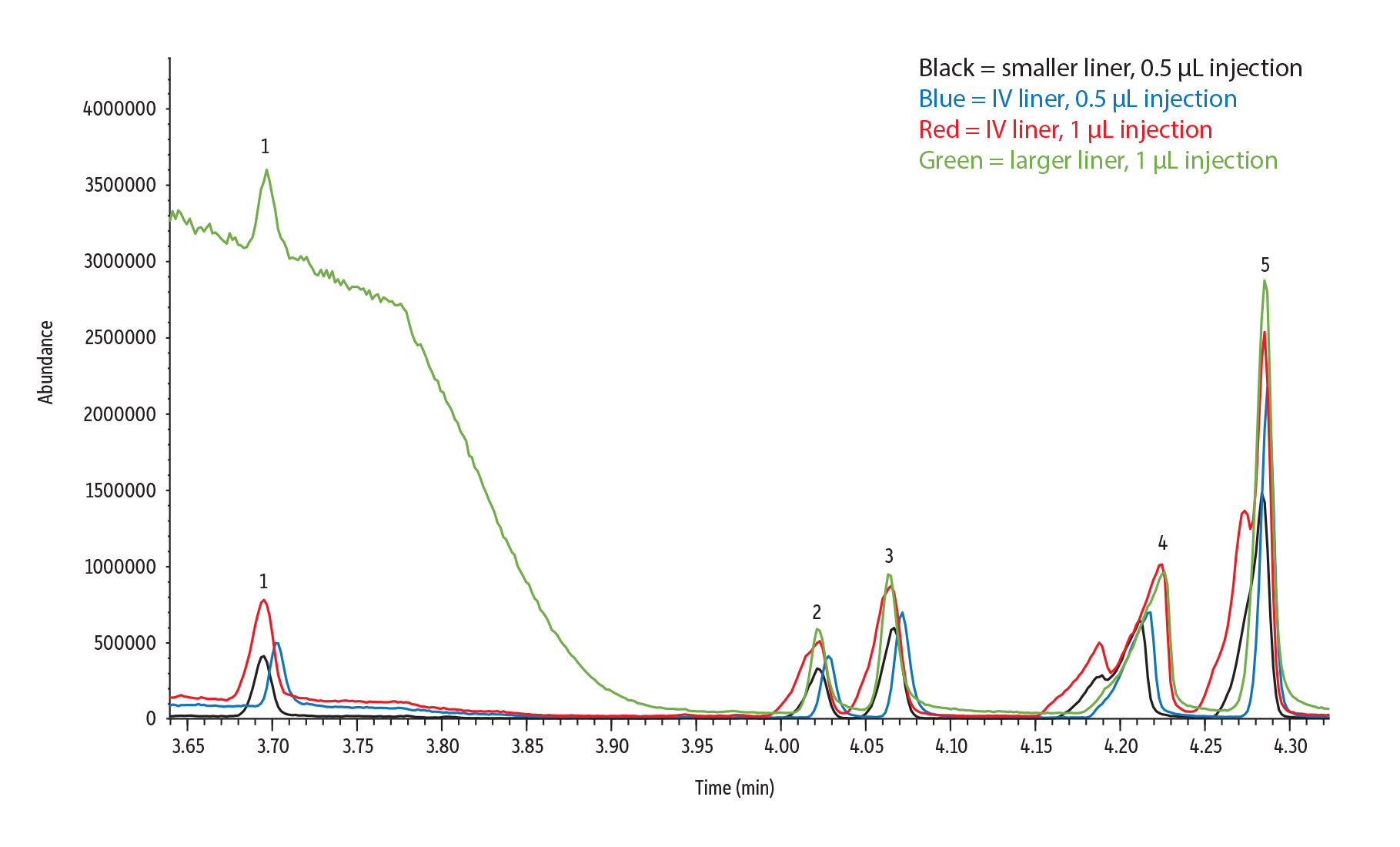
| Peaks | tR (min) | Conc. (µg/mL) | |
|---|---|---|---|
| 1. | Isophorone | 3.696 | 1 |
| 2. | 1,3-Dimethyl-2-nitrobenzene | 4.02 | 1 |
| 3. | Naphthalene | 4.067 | 1 |
| 4. | Methamidophos | 4.223 | 1 |
| 5. | Dichlorvos | 4.286 | 1 |
| Column | Rxi-SVOCms GC capillary column, 20 m, 0.15 mm ID, 0.15 µm (cat.# 46616) |
|---|---|
| Standard/Sample | Method 525.2 semivolatile mix (revised), acetone, 1 mL/ampul (cat.# 31899) |
| Method 525.2 internal standard mix, 1000 µg/mL, acetone, 1 mL/ampul (cat.# 31825) | |
| Method 525.2 surrogate standard mix, 1000 µg/mL, acetone, 1 mL/ampul (cat.# 31826) | |
| Organophosphorus pesticide mix, European formulation, acetone, 1 mL/ampul (cat.# 32418) | |
| Diluent: | Acetone |
| Injection | |
| Inj. Vol.: | 0.5-1 µL splitless (hold 3 min) |
| Liner: | Three Topaz single taper, splitless inlet liners with quartz wool and premium deactivation were compared. All were 78.5 mm long with a 6.5 mm OD and the following IDs: 2.0 mm (cat.# 23316); 3.0 mm (cat.# 27231); and 4.0 mm (cat.# 23303). |
| Inj. Temp.: | 250 °C |
| Purge Flow: | 15 mL/min |
| Oven | |
| Oven Temp.: | 45 °C (hold 0.5 min) to 260 °C at 30 °C/min to 330 °C at 4 °C/min |
| Carrier Gas | He, constant flow |
| Flow Rate: | 0.84 mL/min |
| Linear Velocity: | 40.807 cm/sec @ 45 °C |
| Dead Time: | 0.82 min @ 45 °C |
| Detector | MS | ||||||||
|---|---|---|---|---|---|---|---|---|---|
| Mode: | Scan | ||||||||
| Scan Program: | |||||||||
| |||||||||
| Transfer Line Temp.: | 250 °C | ||||||||
| Analyzer Type: | Quadrupole | ||||||||
| Source Type: | Extractor | ||||||||
| Source Temp.: | 230 °C | ||||||||
| Quad Temp.: | 150 °C | ||||||||
| Electron Energy: | 929 eV | ||||||||
| Solvent Delay Time: | 1.5 min | ||||||||
| Tune Type: | PFTBA | ||||||||
| Ionization Mode: | EI | ||||||||
| Instrument | Agilent 7890A GC & 5975C MSD | ||||||||
| Sample Preparation | 2 μL of cat.# 31899, 31825, 31826 and 20 μL of cat.# 32418 were added to 1974 μL of acetone. Splitless injections were performed with a 10 μL SGE autosampler syringe (cat.# 24795). | ||||||||
Figure 4: Taller, narrower peaks are obtained throughout the run with an IV liner compared to a larger volume liner.

| Peaks | tR (min) | Conc. (µg/mL) | |
|---|---|---|---|
| 1. | Tolclofos-methyl 57018-04-9 | 7.02 | 1 |
| 2. | Pirimiphos methyl 29232-93-7 | 7.14 | 1 |
| 3. | Di-n-butylphthalate 84-74-2 | 7.2 | 1 |
| 4. | Malathion 121-75-5 | 7.22 | 2 |
| 5. | Chlorpyrifos 2921-88-2 | 7.28 | 1 |
| Peaks | tR (min) | Conc. (µg/mL) | |
|---|---|---|---|
| 6. | Fluoranthene 206-44-0 | 7.68 | 1 |
| 7. | Methidathion 950-37-8 | 7.73 | 2 |
| 8. | Pyrene-d10 1718-52-1 | 7.86 | 1 |
| 9. | Pyrene 129-00-0 | 7.87 | 1 |
| 10. | Prothiofos 34643-46-4 | 7.92 | 2 |
| 11. | Profenofos 41198-08-7 | 7.95 | 2 |
| Column | Rxi-SVOCms GC capillary column, 20 m, 0.15 mm ID, 0.15 µm (cat.# 46616) |
|---|---|
| Standard/Sample | Method 525.2 semivolatile mix (revised), acetone, 1 mL/ampul (cat.# 31899) |
| Method 525.2 internal standard mix, 1000 µg/mL, acetone, 1 mL/ampul (cat.# 31825) | |
| Method 525.2 surrogate standard mix, 1000 µg/mL, acetone, 1 mL/ampul (cat.# 31826) | |
| Organophosphorus pesticide mix, European formulation, acetone, 1 mL/ampul (cat.# 32418) | |
| Diluent: | Acetone |
| Injection | |
| Inj. Vol.: | 0.5-1 µL splitless (hold 3 min) |
| Liner: | Three Topaz single taper, splitless inlet liners with quartz wool and premium deactivation were compared. All were 78.5 mm long with a 6.5 mm OD and the following IDs: 2.0 mm (cat.# 23316); 3.0 mm (cat.# 27231); and 4.0 mm (cat.# 23303). |
| Inj. Temp.: | 250 °C |
| Purge Flow: | 15 mL/min |
| Oven | |
| Oven Temp.: | 45 °C (hold 0.5 min) to 260 °C at 30 °C/min to 330 °C at 4 °C/min |
| Carrier Gas | He, constant flow |
| Flow Rate: | 0.84 mL/min |
| Linear Velocity: | 40.807 cm/sec @ 45 °C |
| Dead Time: | 0.82 min @ 45 °C |
| Detector | MS | ||||||||
|---|---|---|---|---|---|---|---|---|---|
| Mode: | Scan | ||||||||
| Scan Program: | |||||||||
| |||||||||
| Transfer Line Temp.: | 250 °C | ||||||||
| Analyzer Type: | Quadrupole | ||||||||
| Source Type: | Extractor | ||||||||
| Source Temp.: | 230 °C | ||||||||
| Quad Temp.: | 150 °C | ||||||||
| Electron Energy: | 929 eV | ||||||||
| Solvent Delay Time: | 1.5 min | ||||||||
| Tune Type: | PFTBA | ||||||||
| Ionization Mode: | EI | ||||||||
| Instrument | Agilent 7890A GC & 5975C MSD | ||||||||
| Sample Preparation | 2 μL of cat.# 31899, 31825, 31826 and 20 μL of cat.# 32418 were added to 1974 μL of acetone. Splitless injections were performed with a 10 μL SGE autosampler syringe (cat.# 24795). | ||||||||
Figure 5: Improvements in peak height and symmetry were also observed for late eluting peaks when using a IV liner.
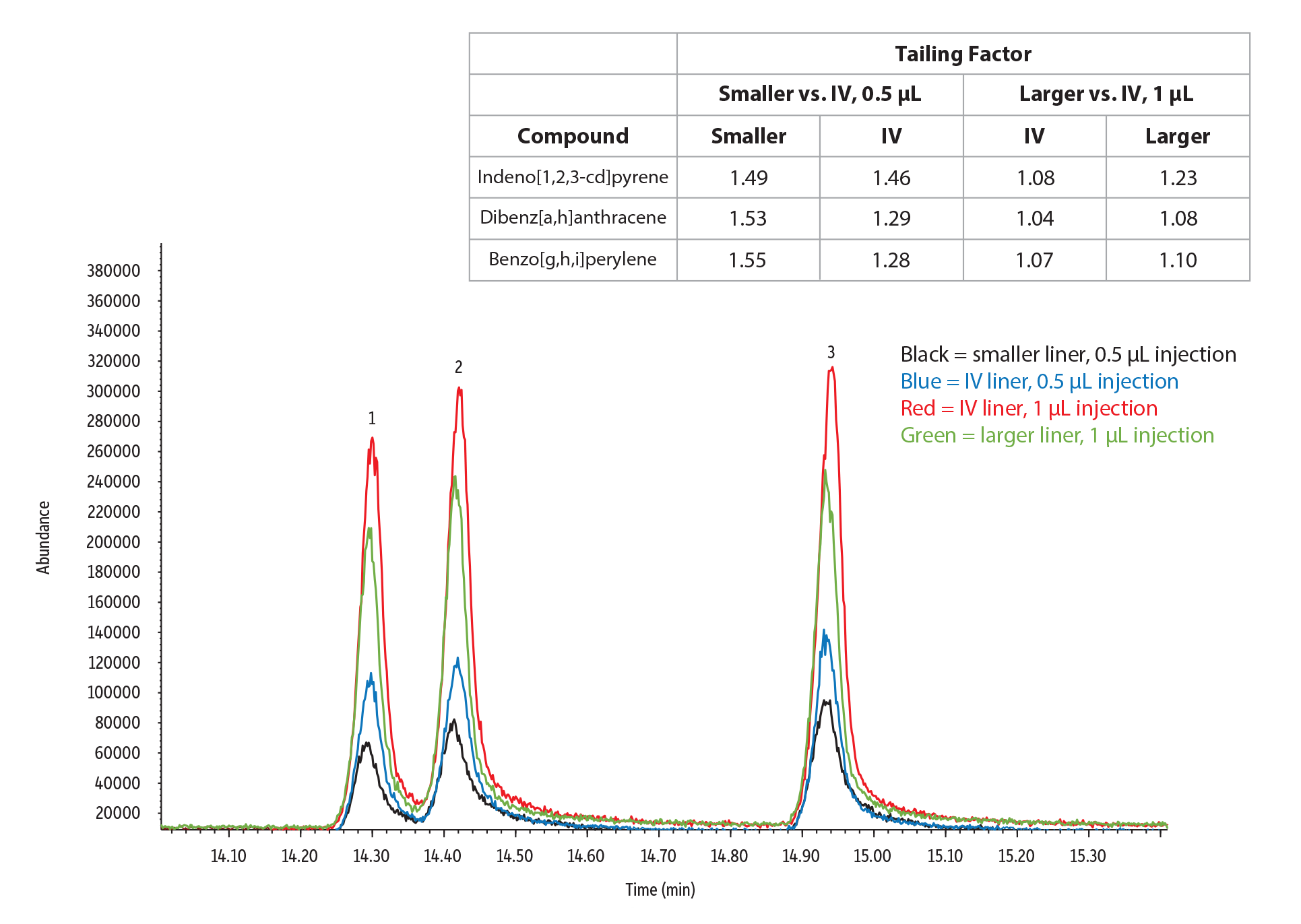
| Peaks | tR (min) | Conc. (µg/mL) | |
|---|---|---|---|
| 1. | Indeno[1,2,3-cd]pyrene | 14.3 | 1 |
| 2. | Dibenz[a,h]anthracene | 14.42 | 1 |
| 3. | Benzo[g,h,i]perylene | 14.94 | 1 |
| Column | Rxi-SVOCms GC capillary column, 20 m, 0.15 mm ID, 0.15 µm (cat.# 46616) |
|---|---|
| Standard/Sample | Method 525.2 semivolatile mix (revised), acetone, 1 mL/ampul (cat.# 31899) |
| Method 525.2 internal standard mix, 1000 µg/mL, acetone, 1 mL/ampul (cat.# 31825) | |
| Method 525.2 surrogate standard mix, 1000 µg/mL, acetone, 1 mL/ampul (cat.# 31826) | |
| Organophosphorus pesticide mix, European formulation, acetone, 1 mL/ampul (cat.# 32418) | |
| Diluent: | Acetone |
| Injection | |
| Inj. Vol.: | 0.5-1 µL splitless (hold 3 min) |
| Liner: | Three Topaz single taper, splitless inlet liners with quartz wool and premium deactivation were compared. All were 78.5 mm long with a 6.5 mm OD and the following IDs: 2.0 mm (cat.# 23316); 3.0 mm (cat.# 27231); and 4.0 mm (cat.# 23303). |
| Inj. Temp.: | 250 °C |
| Purge Flow: | 15 mL/min |
| Oven | |
| Oven Temp.: | 45 °C (hold 0.5 min) to 260 °C at 30 °C/min to 330 °C at 4 °C/min |
| Carrier Gas | He, constant flow |
| Flow Rate: | 0.84 mL/min |
| Linear Velocity: | 40.807 cm/sec @ 45 °C |
| Dead Time: | 0.82 min @ 45 °C |
| Detector | MS | ||||||||
|---|---|---|---|---|---|---|---|---|---|
| Mode: | Scan | ||||||||
| Scan Program: | |||||||||
| |||||||||
| Transfer Line Temp.: | 250 °C | ||||||||
| Analyzer Type: | Quadrupole | ||||||||
| Source Type: | Extractor | ||||||||
| Source Temp.: | 230 °C | ||||||||
| Quad Temp.: | 150 °C | ||||||||
| Electron Energy: | 929 eV | ||||||||
| Solvent Delay Time: | 1.5 min | ||||||||
| Tune Type: | PFTBA | ||||||||
| Ionization Mode: | EI | ||||||||
| Instrument | Agilent 7890A GC & 5975C MSD | ||||||||
| Sample Preparation | 2 μL of cat.# 31899, 31825, 31826 and 20 μL of cat.# 32418 were added to 1974 μL of acetone. Splitless injections were performed with a 10 μL SGE autosampler syringe (cat.# 24795). | ||||||||
Analysis of PAHs
For the PAH evaluation, we selected a narrow-bore Rxi-PAH column (40 m x 0.18 mm ID x 0.07 µm; cat.# 49316) because the column’s efficiency and unique selectivity is optimized for comprehensive PAH analysis. This column has been proven to separate critical compounds, including the benzo [b], [k], and [j] fluoranthenes, while still eluting heavier PAHs in a short analysis time. PAH testing was done using 31 compounds (cat.#s 31899 and 32547) diluted to 1 µg/mL, which were analyzed using the same liner dimensions and injection volumes that were used in the semivolatiles experiment.
Improvements were again seen using the intermediate-volume IV liner compared to the larger volume liner when making 1 µL injections. In the overall quantitative assessment, 94% of the PAHs had greater peak areas, and 74% showed greater peak height with the IV liner (Figure 6). As in the semivolatiles comparison, these results were both statistically significant. As an example of chromatographic performance, Figure 7 illustrates gains in peak area, height, and symmetry that were seen for later eluting compounds due to the IV liner’s more efficient sample transfer onto the narrow-bore column compared to transfer with the larger volume liner.
Results comparing the IV liner and smaller volume liner were more complex. In contrast to the semivolatiles results, PAH peak area and height were statistically higher on the smaller liner than on the IV liner. This may be attributable to the greater retention of PAHs on the Rxi-PAH column overall, regardless of liner, which could minimize the measurable benefits related to solvent interactions that were seen for PAHs on the Rxi-SVOCms column. Interestingly, for peak width and separation, qualitatively narrower peaks and increased resolution were obtained for the majority of PAHs when using a IV liner compared to either the smaller or larger volume liners, although these results were not statistically significant. Figure 8 demonstrates that the narrower peaks obtained with a IV liner resulted in greater peak symmetry and resolution for PAHs than with the smaller volume liner even though the peaks were shorter. Taken in whole, the IV liner provided important advantages for PAH analysis on a narrow-bore column.
Figure 6: Effect of Liner on Chromatographic Performance for PAHs on a Narrow-Bore Rxi-PAH Column
Figure 7: Peak area, height, and symmetry were both improved for challenging PAHs using an IV liner compared to the larger volume liner.
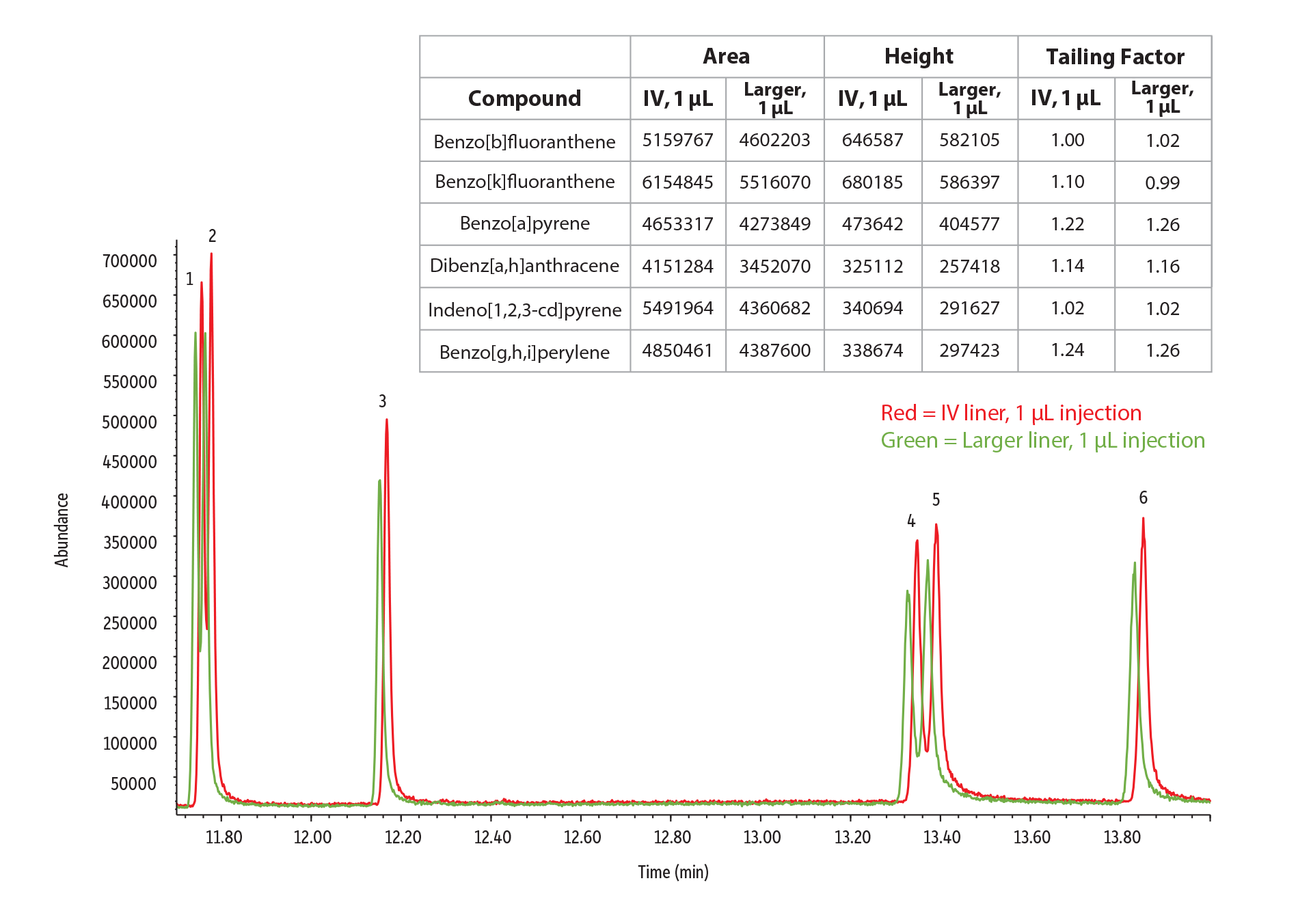
| Peaks | tR (min) | Conc. (µg/mL) | |
|---|---|---|---|
| 1. | Benzo[b]fluoranthene 205-99-2 | 11.76 | 1 |
| 2. | Benzo[k]fluoranthene 207-08-9 | 11.78 | 1 |
| 3. | Benzo[a]pyrene 50-32-8 | 12.17 | 1 |
| 4. | Dibenz[a,h]anthracene 53-70-3 | 13.35 | 1 |
| 5. | Indeno[1,2,3-cd]pyrene 193-39-5 | 13.39 | 1 |
| 6. | Benzo[g,h,i]perylene 191-24-2 | 13.85 | 1 |
| Column | Rxi-PAH GC capillary column, 40 m, 0.18 mm ID, 0.07 µm (cat.# 49316) |
|---|---|
| Standard/Sample | Method 525.2 semivolatile mix (revised), acetone, 1 mL/ampul (cat.# 31899) |
| EPA Method 525.3 PAH IS mix, 500 µg/mL ea. in acetone, 1 mL/ampul (cat.# 32547) | |
| Diluent: | Acetone |
| Injection | |
| Inj. Vol.: | 0.5-1 µL splitless (hold 3 min) |
| Liner: | Three Topaz single taper, splitless inlet liners with quartz wool and premium deactivation were compared. All were 78.5 mm long with a 6.5 mm OD and the following IDs: 2.0 mm (cat.# 23316); 3.0 mm (cat.# 27231); and 4.0 mm (cat.# 23303). |
| Inj. Temp.: | 250 °C |
| Purge Flow: | 15 mL/min |
| Oven | |
| Oven Temp.: | 35 °C (hold 0.5 min) to 350 °C at 30 °C/min (hold 4 min) |
| Carrier Gas | He, constant flow |
| Flow Rate: | 1.44 mL/min |
| Linear Velocity: | 37.587 cm/sec @ 35 °C |
| Dead Time: | 1.77 min @ 35 °C |
| Detector | MS | ||||||||
|---|---|---|---|---|---|---|---|---|---|
| Mode: | Scan | ||||||||
| Scan Program: | |||||||||
| |||||||||
| Transfer Line Temp.: | 250 °C | ||||||||
| Analyzer Type: | Quadrupole | ||||||||
| Source Type: | Extractor | ||||||||
| Source Temp.: | 230 °C | ||||||||
| Quad Temp.: | 150 °C | ||||||||
| Electron Energy: | 929 eV | ||||||||
| Solvent Delay Time: | 1.5 min | ||||||||
| Tune Type: | PFTBA | ||||||||
| Ionization Mode: | EI | ||||||||
| Instrument | Agilent 7890A GC & 5975C MSD | ||||||||
| Sample Preparation | 3 μL of cat.# 31899 and 6 μL of cat.# 32547 were added to 2991 μL of acetone. Splitless injections were performed with a 10 μL SGE autosampler syringe (cat.# 24795). | ||||||||
Figure 8: Even though height decreased, resolution increased on the IV liner because the peaks were narrower.
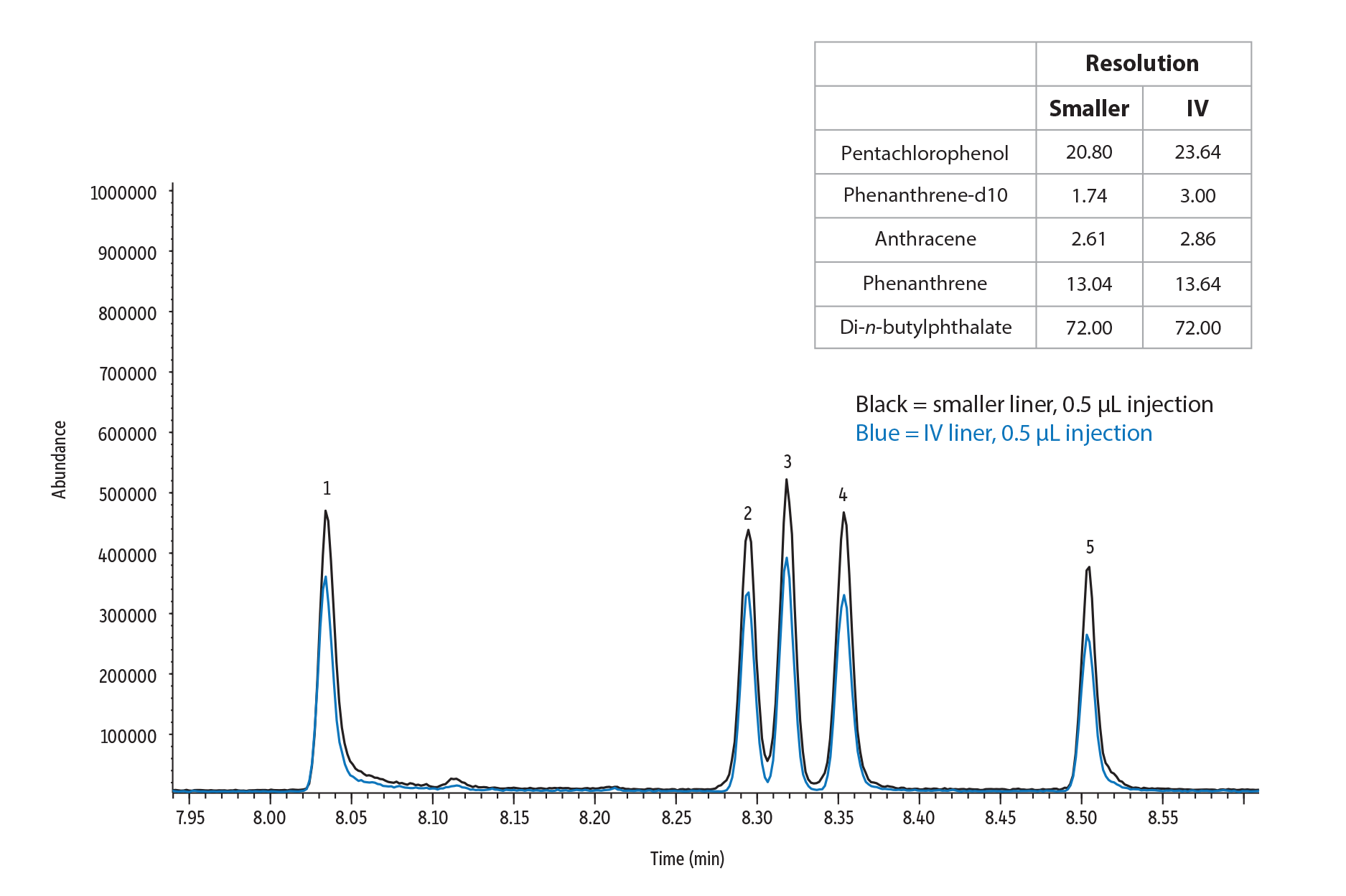
| Peaks | tR (min) | Conc. (µg/mL) | |
|---|---|---|---|
| 1. | Pentachlorophenol | 8.03 | 1 |
| 2. | Phenanthrene-d10 | 8.29 | 1 |
| 3. | Anthracene | 8.32 | 1 |
| 4. | Phenanthrene | 8.35 | 1 |
| 5. | Di-n-butylphthalate | 8.5 | 1 |
| Column | Rxi-PAH GC capillary column, 40 m, 0.18 mm ID, 0.07 µm (cat.# 49316) |
|---|---|
| Standard/Sample | Method 525.2 semivolatile mix (revised), acetone, 1 mL/ampul (cat.# 31899) |
| EPA Method 525.3 PAH IS mix, 500 µg/mL ea. in acetone, 1 mL/ampul (cat.# 32547) | |
| Diluent: | Acetone |
| Injection | |
| Inj. Vol.: | 0.5-1 µL splitless (hold 3 min) |
| Liner: | Three Topaz single taper, splitless inlet liners with quartz wool and premium deactivation were compared. All were 78.5 mm long with a 6.5 mm OD and the following IDs: 2.0 mm (cat.# 23316); 3.0 mm (cat.# 27231); and 4.0 mm (cat.# 23303). |
| Inj. Temp.: | 250 °C |
| Purge Flow: | 15 mL/min |
| Oven | |
| Oven Temp.: | 35 °C (hold 0.5 min) to 350 °C at 30 °C/min (hold 4 min) |
| Carrier Gas | He, constant flow |
| Flow Rate: | 1.44 mL/min |
| Linear Velocity: | 37.587 cm/sec @ 35 °C |
| Dead Time: | 1.77 min @ 35 °C |
| Detector | MS | ||||||||
|---|---|---|---|---|---|---|---|---|---|
| Mode: | Scan | ||||||||
| Scan Program: | |||||||||
| |||||||||
| Transfer Line Temp.: | 250 °C | ||||||||
| Analyzer Type: | Quadrupole | ||||||||
| Source Type: | Extractor | ||||||||
| Source Temp.: | 230 °C | ||||||||
| Quad Temp.: | 150 °C | ||||||||
| Electron Energy: | 929 eV | ||||||||
| Solvent Delay Time: | 1.5 min | ||||||||
| Tune Type: | PFTBA | ||||||||
| Ionization Mode: | EI | ||||||||
| Instrument | Agilent 7890A GC & 5975C MSD | ||||||||
| Sample Preparation | 3 μL of cat.# 31899 and 6 μL of cat.# 32547 were added to 2991 μL of acetone. Splitless injections were performed with a 10 μL SGE autosampler syringe (cat.# 24795). | ||||||||
Analysis of Pesticides
Our final experiment assessed whether an intermediate-volume IV liner could improve narrow-bore column performance for pesticides analysis. For this application, we analyzed a standard containing 20 pesticides (cat.#s 32279, 32280, 32281, 32282, and 32418) at 1-10 µg/mL on an Rxi-5ms column (20 m x 0.18 mm ID x 0.18 µm; cat.# 13402). The Rxi-5ms is a general-purpose column fortified with ultra-low bleed chemistries that make analysis easy across a variety of applications. Injection volumes and liner dimensions were the same as the previous experiments.
For the 1 µL injections, performance improvements were again seen with the IV liner. Figure 9 demonstrates that peak area and height were statistically improved when using the intermediate-volume IV liner compared to the larger volume liner, a result that was consistent with the semivolatiles and PAH experiments. Peak width, resolution, and symmetry did not vary significantly between the liner volumes. Figure 10 shows an example of the height increase obtained using the IV liner compared to the larger liner. The faster transfer made possible with the IV liner once again lent significant improvements for peak identification.
Results for the 0.5 µL injections were similar to the PAH results in that peak area and height decreased significantly with the IV liner, but qualitative improvements were seen for peak width, resolution, and symmetry for the majority of compounds (Figure 9), though they were not statistically different. The decrease in peak area and height may be due to the slightly less efficient transfer obtained when using intermediate versus smaller volume liners. While not quantitative, one of the main improvements observed with the IV liner is reduced peak splitting early in the chromatogram (Figure 11). While all liner and volume combinations demonstrated some peak splitting for early eluting compounds, the split was most reduced when 0.5 µL injections were made with the intermediate-volume IV liner. Peak identification and quantitation for early eluting compounds should be improved as the result of decreased peak splitting and solvent effects, but more adjustments are necessary to eliminate peak splitting entirely. Restek’s GC troubleshooting video series provides helpful tips for reducing peak splitting and other issues. Overall, for 0.5 µL injections, the IV liner was the most effective choice for early eluting pesticides because the additional capacity and distance from the solvent peak minimized peak splitting.
Figure 9: Effect of Liner on Chromatographic Performance for Pesticides on a Narrow-Bore Rxi-5ms Column
Figure 10: Improved peak height when using the IV liner for 1 µL injections compared to the larger volume liner.
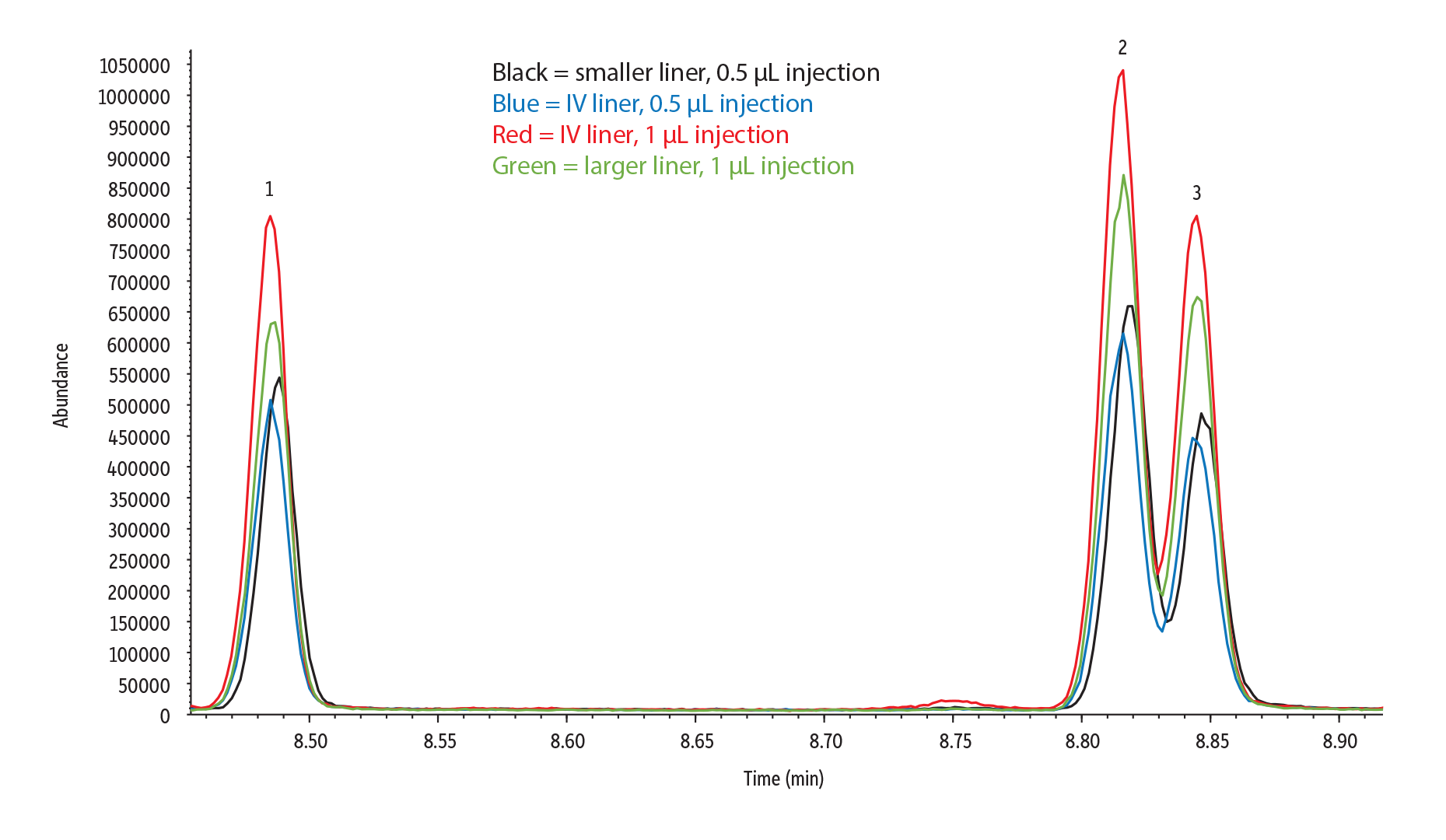
| Peaks | tR (min) | Conc. (µg/mL) | |
|---|---|---|---|
| 1. | Methidathion | 8.49 | 2 |
| 2. | Prothiofos | 8.82 | 2 |
| 3. | Profenofos | 8.85 | 2 |
| Column | Rxi-5ms GC capillary column, 20 m, 0.18 mm ID, 0.18 µm (cat.# 13402) |
|---|---|
| Standard/Sample | Organophosphorus pesticide mix, European formulation, acetone, 1 mL/ampul (cat.# 32418) |
| 1-Bromo-2-nitrobenzene internal standard, 1000 µg/mL, acetone, 1 mL/ampul (cat.# 32279) | |
| Tributylphosphate standard, 1000 µg/mL, acetone, 1 mL/ampul (cat.# 32280) | |
| Triphenylphosphate standard, 1000 µg/mL, acetone, 1 mL/ampul (cat.# 32281) | |
| 4-Chloro-3-nitrobenzotrifluoride standard, 1000 µg/mL, acetone, 1 mL/ampul (cat.# 32282) | |
| Diluent: | Acetone |
| Injection | |
| Inj. Vol.: | 0.5-1 µL splitless (hold 3 min) |
| Liner: | Three Topaz single taper, splitless inlet liners with quartz wool and premium deactivation were compared. All were 78.5 mm long with a 6.5 mm OD and the following IDs: 2.0 mm (cat.# 23316); 3.0 mm (cat.# 27231); and 4.0 mm (cat.# 23303). |
| Inj. Temp.: | 250 °C |
| Purge Flow: | 15 mL/min |
| Oven | |
| Oven Temp.: | 35 °C (hold 0.5 min) to 220 °C at 30 °C/min to 240 °C at 8 °C/min to 315 °C at 23 °C/min (hold 10 min) |
| Carrier Gas | He, constant flow |
| Flow Rate: | 1.01 mL/min |
| Linear Velocity: | 44.518 cm/sec @ 35 °C |
| Dead Time: | 0.75 min @ 35 °C |
| Detector | MS | ||||||||
|---|---|---|---|---|---|---|---|---|---|
| Mode: | Scan | ||||||||
| Scan Program: | |||||||||
| |||||||||
| Transfer Line Temp.: | 250 °C | ||||||||
| Analyzer Type: | Quadrupole | ||||||||
| Source Type: | Extractor | ||||||||
| Source Temp.: | 230 °C | ||||||||
| Quad Temp.: | 150 °C | ||||||||
| Electron Energy: | 929 eV | ||||||||
| Solvent Delay Time: | 1.5 min | ||||||||
| Tune Type: | PFTBA | ||||||||
| Ionization Mode: | EI | ||||||||
| Instrument | Agilent 7890A GC & 5975C MSD | ||||||||
| Sample Preparation | 3 μL of cat.# 32279, 32280, 32281, 32282 and 42 μL of cat.# 32418 were added to 3012 μL of acetone. Splitless injections were performed with a 10 μL SGE autosampler syringe (cat.# 24795). | ||||||||
Figure 11: Peak splitting occurred for early eluting compounds with all liners and injection volumes, but it was minimized by injecting 0.5 µL in an IV liner.
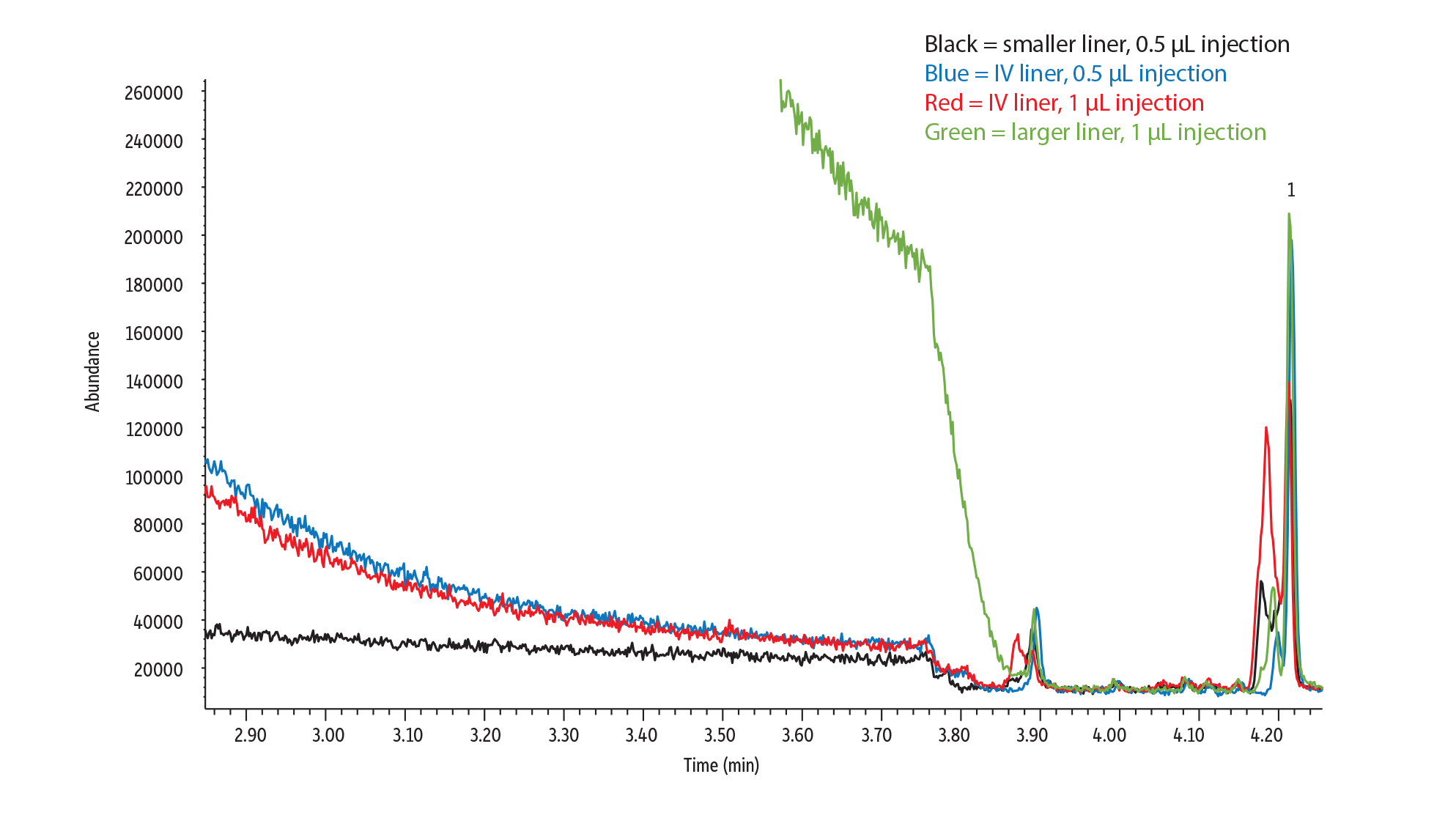
| Peaks | tR (min) | Conc. (µg/mL) | |
|---|---|---|---|
| 1. | 4-Chloro-3-nitrobenzotrifluoride | 4.206 | 1 |
| Column | Rxi-5ms GC capillary column, 20 m, 0.18 mm ID, 0.18 µm (cat.# 13402) |
|---|---|
| Standard/Sample | Organophosphorus pesticide mix, European formulation, acetone, 1 mL/ampul (cat.# 32418) |
| 1-Bromo-2-nitrobenzene internal standard, 1000 µg/mL, acetone, 1 mL/ampul (cat.# 32279) | |
| Tributylphosphate standard, 1000 µg/mL, acetone, 1 mL/ampul (cat.# 32280) | |
| Triphenylphosphate standard, 1000 µg/mL, acetone, 1 mL/ampul (cat.# 32281) | |
| 4-Chloro-3-nitrobenzotrifluoride standard, 1000 µg/mL, acetone, 1 mL/ampul (cat.# 32282) | |
| Diluent: | Acetone |
| Injection | |
| Inj. Vol.: | 0.5-1 µL splitless (hold 3 min) |
| Liner: | Three Topaz single taper, splitless inlet liners with quartz wool and premium deactivation were compared. All were 78.5 mm long with a 6.5 mm OD and the following IDs: 2.0 mm (cat.# 23316); 3.0 mm (cat.# 27231); and 4.0 mm (cat.# 23303). |
| Inj. Temp.: | 250 °C |
| Purge Flow: | 15 mL/min |
| Oven | |
| Oven Temp.: | 35 °C (hold 0.5 min) to 220 °C at 30 °C/min to 240 °C at 8 °C/min to 315 °C at 23 °C/min (hold 10 min) |
| Carrier Gas | He, constant flow |
| Flow Rate: | 1.01 mL/min |
| Linear Velocity: | 44.518 cm/sec @ 35 °C |
| Dead Time: | 0.75 min @ 35 °C |
| Detector | MS | ||||||||
|---|---|---|---|---|---|---|---|---|---|
| Mode: | Scan | ||||||||
| Scan Program: | |||||||||
| |||||||||
| Transfer Line Temp.: | 250 °C | ||||||||
| Analyzer Type: | Quadrupole | ||||||||
| Source Type: | Extractor | ||||||||
| Source Temp.: | 230 °C | ||||||||
| Quad Temp.: | 150 °C | ||||||||
| Electron Energy: | 929 eV | ||||||||
| Solvent Delay Time: | 1.5 min | ||||||||
| Tune Type: | PFTBA | ||||||||
| Ionization Mode: | EI | ||||||||
| Instrument | Agilent 7890A GC & 5975C MSD | ||||||||
| Sample Preparation | 3 μL of cat.# 32279, 32280, 32281, 32282 and 42 μL of cat.# 32418 were added to 3012 μL of acetone. Splitless injections were performed with a 10 μL SGE autosampler syringe (cat.# 24795). | ||||||||
Reproducibility
To evaluate reproducibility, the relative standard deviations (%RSD) of averaged parameters across all compounds in all experiments were compared across the different liner sizes and injection volumes (Figure 12). Overall, the intermediate-volume IV liner demonstrated statistically better reproducibility for peak area and height on narrow-bore columns for both injection volumes and at both partial and full capacity (Table II). Results for peak symmetry were also more reproducible using a IV liner, except for the 0.5 µL injections where there was no statistical difference and the midcapacity comparison where symmetry was only 0.1% better using the larger volume liner. Regarding peak width and resolution, there was no statistical difference in performance for most comparisons, but the smaller volume liner did provide more reproducible results for the 0.5 µL injections, while the IV liner provided more reproducible peak widths for the 1.0 µL injections. Since width and resolution are heavily impacted by position in the chromatogram (e.g., early vs. late eluting or during a ramp vs. an isothermal hold), differences in these parameters may be more affected by method conditions other than the liner.
These improvements to reproducibility can be attributed to the ILV liner’s intermediate volume, which better contains injection volumes that may be pushing the capacity of the smaller volume liner. Similarly, the compounds are transferred to the column more efficiently from the IV liner than with the larger volume liner, so there is less time for variations to occur, especially for later eluting compounds.
Figure 12: Average %RSD for different peak parameters across various liner sizes and injection volumes.
Table II: Liner with better reproducibility (statistically lower average %RSD values, p < 0.05) for different peak parameters.
| Liner ID | Area | Height | Width | Resolution | Tailing |
| 0.5 µL injections (IV vs. smaller) | IV | IV | smaller | smaller | ND |
| 1 µL injections (IV vs. larger) | IV | IV | IV | ND | IV |
| Full capacity (IV vs. smaller) | IV | IV | ND | ND | IV |
| Mid-capacity (IV vs. larger) | IV | IV | ND | ND | larger |
ND = no statistical difference (p > 0.05)
Overall Assessment
Table III summarizes the statistical results of all these experiments and provides a high-level evaluation of the effects of liner choice on chromatographic performance when using narrow-bore GC columns with splitless injection. Of the 50 comparisons, 43 (86%) showed the intermediate-volume IV liner provided improved (22/50) or equivalent (21/50) performance compared to smaller and larger volume liners. Results were most pronounced for area and height, which are critical for accurate peak identification and quantification. Effects were more varied for width, resolution, and symmetry, but these parameters can also be strongly affected by the other method conditions (isothermal temperatures, column phase, solubility, etc.) and elution time.
Based on this data, IV liners will provide more balanced and improved chromatographic performance compared to smaller and larger volume liners. When using IV liners with narrow-bore columns, more sample can be injected compared to smaller liners, reducing the negative effects caused by solvent and liner capacity. In addition, compared to larger volume liners, the sample is introduced onto the column more quickly and in a narrower band, taking better advantage of the column’s intrinsic high efficiency.
In conclusion, the intermediate volume of IV liners contributes to fast, sensitive, and highly reproducible analyses, which allows labs to maximize the benefits of narrow-bore columns. Note that if you switch an existing method to a narrow-bore column, it is important to properly scale other method parameters to maintain peak separations. Restek’s free, online EZGC method translator is a quick and simple tool that can be used to generate properly translated method conditions for narrow-bore columns.
Table III: 86% (43/50) of the experimental comparisons evaluated here showed better performance or no statistical difference when using an IV liner with narrow-bore columns.
| Liner with Best Performance (p < 0.05) | |||||
| Increased Area | Increased Height | Decreased Width | Increased Resolution | Decreased Tailing | |
| Semivolatiles |
|||||
| IV vs. larger (1 µL) | IV | IV | ND | ND | ND |
| IV vs. smaller (0.5 µL) | IV | IV | IV | IV | IV |
| PAHs | |||||
| IV vs. larger (1 µL) | IV | IV | ND | ND | ND |
| IV vs. smaller (0.5 µL) | smaller | smaller | ND | ND | ND |
| Pesticides | |||||
| IV vs. larger (1 µL) | IV | IV | ND | ND | ND |
| IV vs. smaller (0.5 µL) | smaller | smaller | ND | ND | ND |
| Reproducibility | |||||
| IV vs. larger (1 µL) | IV | IV | IV | ND | IV |
| IV vs. smaller (0.5 µL) | IV | IV | smaller | smaller | ND |
| Full capacity (smaller vs. IV) | IV | IV | ND | ND | IV |
| Mid-capacity (larger vs. IV) | IV | IV | ND | ND | larger |
ND = no statistical difference (p > 0.05)

